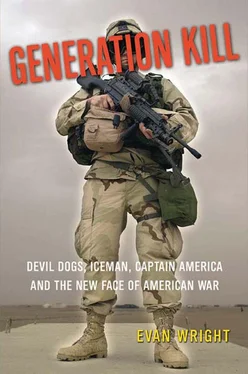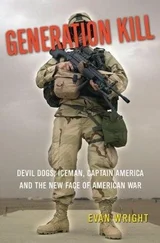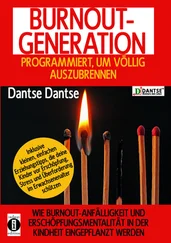Each Humvee is equipped with either a .50-caliber machine gun or an MK-19 (usually referred to as a “Mark-19”). The .50-cal, as the machine gun is called, is a heavy weapon, with a barrel about a meter long, that fires steel-penetrating rounds that will rip apart cars or trucks a kilometer away but won’t do much against a tank. The Mark-19, which resembles one of those machines that fire tennis balls on a practice court, launches grenades at a rate of about one per second. These grenade rounds also have an effective range of about a kilometer. The heavy weapons can devastate infantry on the ground, destroy bunkers and wreck mud-brick or cement structures in Iraqi towns, but they’re not really meant to stop tanks or take on large mechanized forces.
Despite the imposing size Humvees appear to have when you see civilian versions on the streets, there’s barely any room inside Colbert’s. Everyone is bulked up with their helmets, vests, MOPP suits and rubber boots. The vehicle is crammed with boxes of military food rations, several five-gallon cans of water, extra diesel fuel, more than 300 grenades, a few thousand rounds of rifle and machine-gun ammunition, special smoke and thermite incendiary grenades, several pounds of C-4 plastic explosive, claymore mines, a bale of concertina wire, cammie nets, a spare tire, extra parts, fluids and filters for the engine, a tool set, bolt cutters, map books, bags of ropes, a fire extinguisher, five rucksacks of personal gear, chemlites, several hundred extra batteries for the portable radios, shovels, a pickax, a sledgehammer and, suspended by parachute cord from the rear interior roof, an AT-4 antitank missile, which continually bangs against the back of my helmet.
It is pitch black inside and out. For obvious reasons, nobody uses headlights during an invasion. All mirrors have been removed. You can barely see over the dashboard, since the center console is stacked with three radios, each about the size of an old VCR.
Both Person and Colbert have radio transceivers clipped to their helmets to communicate with vehicles in the platoon, as well as with the battalion and with pilots when there is air cover. It’s arguable that comms—radio communications—are as important to a team’s survival as its weapons. But comms seldom work as they should.
Dust, magnetism and sun spots all interfere with the radios constantly. In addition, the radios in the various battalion networks rely on encryption codes that constantly need to be loaded and synchronized. The system is prone to bad connections, dead batteries, software crashes and, as Person explains, “retards in the battalion who keep changing the frequencies without telling us.” Even in the best of times, the radios blink out. Colbert and Person often end up shouting the same commands and queries into their microphones until the signals go through.
Luckily, Person is something of a genius when it comes to radios. The reason he’s on Colbert’s team is that despite his constant mockery of everything, Colbert considers him one of the most competent Marines in the platoon. He has voluminous knowledge of encryption protocols and a sixth sense for how to hot-wire bum radios, often by unplugging all the cables and licking the sockets, all while driving in the darkness. Teams in other platoons whose radio operators aren’t as skilled sometimes resort to leaning out their doors and shouting.
Moving in a pitch-black vehicle, bobbing over a rutted desert, unable to see much outside the window except the occasional blob shape of another vehicle, is disorienting, like sitting backward on a train or being in an elevator that drops unexpectedly. You have the nagging sense that you’re about to run into something.
Person sees through the darkness with a set of night-vision goggles (NVGs) clipped over the front of his helmet. NVGs, which weigh a couple of pounds, consist of two lenses that cover each eye, then bend into a barrel that protrudes about five inches. The whole thing looks like a crazy monocular scope you look through during an exam at the eye doctor. They provide a foggy, greenish display of the road ahead, with no depth perception—it’s hard to tell if a vehicle is ten feet or fifty feet in front of you, or if a black shape in the road is a barrel or a hole. If a light flashes, from a fire by the road, a bomb exploding or oncoming headlights, the wearer of NVGs is temporarily blinded.
Since there are no mirrors or rear window on the Humvee, in order to back up or make a sharp turn, Person shouts up to Garza, who stands in the turret wearing his own set of NVGs, to ask him what’s there. Because the Humvee’s diesel is loud, the wind is always blowing, the radios are crackling in and out and there are more and more explosions as we near the border, just keeping the Humvee in the convoy requires continual shouting from everyone inside.
Person, like many other Marines in First Recon, has practiced driving a Humvee at night with NVGs only a few times. Nor does he have a military operating license for a Humvee. There are right now some 75,000 soldiers and Marines in thousands of vehicles converging on a handful of breaches in the berms at the border. There is as much traffic rolling as there is on sections of the San Diego Freeway at rush hour, only it’s dark and everyone’s in tanks and heavily armed Humvees. It’s a wonder the whole invasion doesn’t end in a gigantic pileup by the border. Most of the drivers are amped-up nineteen- and twenty-year-olds, wrestling with the same problems Person has—the limitations of NVGs, screwy comms and orders that change constantly.
All of this is happening beneath a sky that has turned pink, red and orange from the ferocious bombardment being unleashed on Iraqi border positions ten to twenty kilometers in front of us. Rockets and artillery shells fly overhead, filling the air with a cacophony of strange sounds—whistling, rumbling; some rockets make a sizzling sound. The horizon flashes as they impact.
“This is the shit,” Person says as he takes in the destruction in his NVGs, which are exponentially intensifying every flash. “I wish I had some shrooms.”
“Yeah, it’s the shiznit,” Colbert says. “Now, watch the fucking vehicle in front of you.”
With the effects of all the legal stimulants he’s taking starting to show, Person begins to babble, a disembodied voice coming from beneath his helmet and NVGs. “I’ll tell you why we’re invading. Fucking NAMBLA,” he says, referring to the North American Man/Boy Love Association. “Places like Thailand where they go to fuck children and shit, it’s drying up. We’re opening up Iraq for a whole new supply of children.”
“Halt the vehicle, Person,” Colbert says, passing on an order from the radio. “We’re stopping for a few minutes.”
“NAMBLA’s infiltrated First Recon,” Person continues, after bringing the vehicle to a stop. “There’s a guy in Third Platoon, he’s going to be collecting photographs of all the children and sending them back to NAMBLA HQ. Back at Pendleton he volunteers at a daycare center. He goes around collecting all the turds from the five-year-olds and puts them into Copenhagen tins. Out here everyone thinks he’s dipping, but it’s not tobacco. It’s dookie from five-year-olds.”
“Shut up, Person,” Colbert orders.
Next to me, Trombley breaks the silence, speaking in low tones. “I wonder if she’s ever killed anyone,” Trombley says, stroking the barrel of the SAW machine gun, which he holds on his lap, pointed out the window. The SAW, which stands for “squad automatic weapon,” is a portable machine gun capable of firing up to 1,000 rounds per minute. Ammunition comes in 200-round belts, which are several feet long. They fit into a drum beneath the barrel of the SAW, but Trombley likes to take the belts out of the drums and drape them around his neck like Rambo, which provokes sharp rebukes from Colbert whenever he catches him.
Читать дальше












